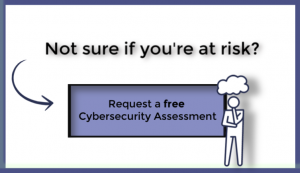Is your data at risk without you realizing it? In 2018, billions of people were affected by data breaches – according to USA Today. By the end of 2019, nearly 8 billion compromised records were reported. We need to be more diligent than ever in 2020, as it is clear that hackers have everything they need to access data that lacks proper security.
Now is the time to assess your company’s exposure.
It’s easy to avoid looking into security needs. It can feel tedious when you don’t know where to begin, but it doesn’t have to be. To help you start thinking it through, we’ve created a list of security risks that your company could be facing. Let’s take a look →
Data Breach or Loss
Breaches can pose costly burdens for your company. While these violations are often achieved by hackers, they can also occur on accident from within. In the event of a system failure, can your organization trust that its onsite backup solution will work as it should? Even if you do trust your solution, what will you do if systems are damaged by flood, fire or other natural disaster? Are you 100% confident with your CSP?
Employee Negligence
Unfortunately, employee negligence can result in an organization’s downfall. Are your employees aware of existing data risks? Have they been provided with guidance on handling these situations? Do they click on embedded links in their spam folder? Do they leave their work unattended? Do they consistently change passwords? Is your sensitive data secured in the event of employee theft? To learn more about how your employees could be exposing your data, read here!
Phishing Scams
These days, one bad URL-click can result in a costly data breach. In fact, more than half of all small businesses have suffered a breach within the last year, and 60% will go out of business within six months of being victimized. Phishing scams are often successful because the emails appear to come from a friend or colleague, and techniques are growing even more sophisticated, making them harder to identify. We can expect that 2020 will pose a whole new world of threats.
Lack of Disaster Recovery
Without utilizing proper recovery services, you are at risk of not only losing your data, but never being able to get it back. Backup and Recovery Solutions should replicate critical documents into the cloud, giving you security and peace of mind – even in the event of a system failure.
Non-Updated Software
More people ignore their software updates than you may realize. These updates make changes to improve the performance and security of your applications, and will ensure that your software runs as safely as it can. Often times, hackers look for outdated software first. Stay ahead of them!
Policies and Procedures
SMBs could be at risk of losing data if they do not enforce their security policies. These policies are important for both employees and customers. They must be communicated across the board to keep your business running as smoothly as possible.
Firewalls are Not Secure
Anyone who uses the internet is at risk of exposure. A firewall is like a barrier that works to protect your information and block certain data. Are you confident that you have proper firewalls set in place to keep your data secure?
Alright, here’s the good news…
There ARE steps you can take right away to better protect your data.
1) Train your staff. Be sure there are no careless mistakes, like leaving written passwords laying around, or clicking attachments before checking where they came from. Once your staff understands the potential losses from an attack, they will be motivated to move carefully and take proper precautions.
2) Monitor your security. A security monitoring service will analyze your information with anti-virus software and detect suspicious behavior on your devices so that you’re protected from incoming threats in a timely manner.
3) Utilize a disaster recovery solution. The appropriate recovery tools will back up your critical data so that, no matter what happens, you can restore the files and folders you need.
4) Update software. Keep browser plug-ins up to date. Turn on automatic updates if you or your employees tend to disregarded the notifications. A few minutes waiting for an update is worth the potential exposure to the cyber crime universe.
5) Use a password management service. We like LastPass. It’s free, and it keeps your passwords in one place so that you never have to remember them! It also reminds users to use long passwords with strong character mixes, and identifies weak existing passwords with prompts to update.
6) Be careful with hot-spots. If you have employees that work outside the office, they may need to do some homework. Remind them not to jump onto the first ‘free WiFi network’ available, and to verify the network with a worker if they are at a public shop. When they’re done working, they can tell their device to ‘Forget the network’ so it doesn’t automatically reconnect. It’s best to have a VPN in place for your organization to use.
When it comes down to it, your data is important, and too much exposure could cost you greatly. That’s why we’re so passionate about what we do.
Let Prestige IT help you stay ahead of any vulnerabilities.



Comments are closed.